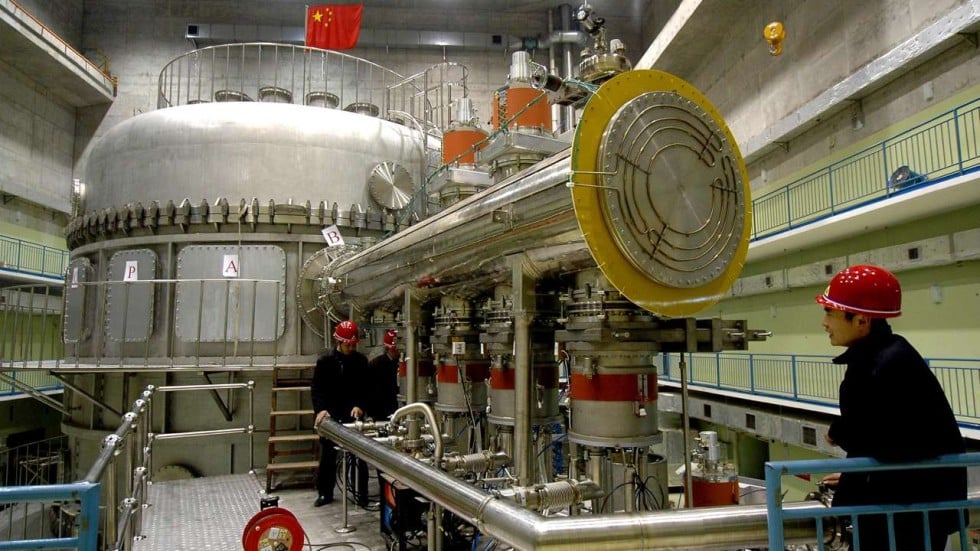Atom molecule in female hand (Shutterstock/ Sergey Nivens)
ANDREW FOLLETT
Energy and Science Reporter
China’s state-controlled TV station claimed Sunday scientists made a major breakthrough in nuclear fusion research.
Chinese researchers claim to have independently invented components to keep ionized gas burning steadily for twice the length of the previous record — an important step forward toward nuclear fusion, if true.
The country allegedly created a component for a fusion reactor core that can withstand extremely high heat.
“The component we invented is one of the first of its kind in the world that has passed the international cyclic heat test,” Cheng Jiming of China National Nuclear Corporation told CCTV. “It really means a lot — it’s a great contribution to the international field of thermonuclear experimental reactors.”

H-mode, in a donut-shaped chamber shielded by a extremely strong electromagnetic field.
CCTV wasn’t clear about what kind of breakthrough allegedly occurred, other than to say China is “leaving other nations in the dust” and will pour more money into fusion research.
China’s component is supposed to be installed on the International Thermonuclear Experimental Reactor (ITER) in France. China provides about 10 percent of the financial support for ITER and has scientists directly involved in the project. It claims the new component is about 20 percent more heat-resistant than the reactor’s design requires.

Experimental Advanced Superconducting Tokamak (EAST) in Anhui’s provincial

ITER members – Japan, South Korea, China, Russia, the US, India and the European Union
ITER was originally expected to cost approximately $5.7 billion. Cost overruns, design changes and rising raw material prices saw the amount almost triple to $ 14.9 billion. The project could end up costing $20 billion.
Scientists in Germany found fusion reactors are feasible earlier this month by determining that an experimental reactor was generating the right kind of magnetic field to trap plasma for long enough for nuclear fusion to occur.
German engineers from the Max Planck Institute successfully activated the experimental nuclear fusion reactor used in the research last December and managed to suspend plasma for the first time. The reactor took 19 years and $1.1 billion to build and contains over 470 tons of superconducting magnets, all of which need to be cooled to absolute zero.
Nuclear fusion is different from conventional nuclear reactors, as fusion causes atoms to join at extremely high temperatures and release huge amounts of energy. The process would generate essentially no hazardous waste and wouldn’t require hazardous fuel.
Operational fusion power would put most other forms of electricity generation permanently out of business and could occur very soon. Fusion power could be “too cheap to meter,”
meaning that the cost of generating new power would be below the cost
of determining how much power an individual was using, effectively
making electricity generation free.
Other recent breakthroughs in fusion could restart the atomic age, an era when nuclear progress was lauded as a pinnacle of human achievement.
Lockheed Martin Skunk Works is developing a compact fusion reactor small enough to fit in a truck and would generate enough electricity to power 80,000 homes.
An American research team in January discovered a way to initiate nuclear fusion reactions in a process called “fast ignition” using a high-intensity laser, according to the American Association for the Advancement of Science. Scientists believe that “fast ignition” could allow a fusion reaction to be controlled, because it requires less “start-up” energy than other methods.
Other recent breakthroughs in fusion could restart the atomic age, an era when nuclear progress was lauded as a pinnacle of human achievement.
Lockheed Martin Skunk Works is developing a compact fusion reactor small enough to fit in a truck and would generate enough electricity to power 80,000 homes.
An American research team in January discovered a way to initiate nuclear fusion reactions in a process called “fast ignition” using a high-intensity laser, according to the American Association for the Advancement of Science. Scientists believe that “fast ignition” could allow a fusion reaction to be controlled, because it requires less “start-up” energy than other methods.

Post a Comment Blogger Facebook Disqus